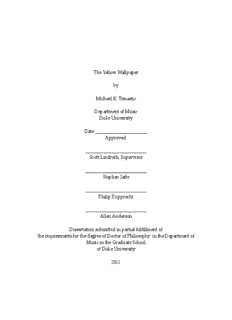Table Of ContentThe Yellow Wallpaper
by
Michael K. Trinastic
Department of Music
Duke University
Date:_______________________
Approved:
___________________________
Scott Lindroth, Supervisor
___________________________
Stephen Jaffe
___________________________
Philip Rupprecht
___________________________
Allen Anderson
Dissertation submitted in partial fulfillment of
the requirements for the degree of Doctor of Philosophy in the Department of
Music in the Graduate School
of Duke University
2011
ABSTRACT
The Yellow Wallpaper
by
Michael K. Trinastic
Department of Music
Duke University
Date:_______________________
Approved:
___________________________
Scott Lindroth, Supervisor
___________________________
Stephen Jaffe
___________________________
Philip Rupprecht
___________________________
Allen Anderson
An abstract of a dissertation submitted in partial
fulfillment of the requirements for the degree
of Doctor of Philosophy in the Department of
Music in the Graduate School
of Duke University
2011
Copyright by
Michael Trinastic
2011
Abstract
The Yellow Wallpaper is a one-act opera for dramatic soprano and chamber
orchestra (eleven players). The libretto is the composer's free adaptation of the
short story "The Yellow Wallpaper" by Charlotte Perkins Gilman. The
instrumentation required is: flute (doubling piccolo), oboe (doubling english
horn), clarinet (doubling bass clarinet and E-flat clarinet), bassoon, horn,
soprano, piano (doubling celesta), violin I, violin II, viola, cello, and contrabass.
The approximate duration is one hour.
iv
Dedication
The Yellow Wallpaper is dedicated to Aimee Marcoux.
v
Contents
Abstract iv
Synopsis vii
On The Yellow Wallpaper x
Performance Notes xxi
The Yellow Wallpaper 1
Biography 248
vi
Synopsis
SCENE 1
The Narrator describes the mansion in the country where she is staying
and recalls the hope she felt upon arriving. Although she finds the place a bit
sinister, she dismisses her misgivings with the thought that her husband John
would consider them silly.
Captivated by the beautiful garden, the Narrator imagines people walking
its paths, but cuts her reverie short, remembering John's admonitions against
flights of fancy. She longs to write, but represses her desire since John has
forbidden her to touch pencil or paper until she is well. Although she feels anger
towards John, she attributes it to her nervous condition. Remembering that John
is a doctor, that he loves her, and that they came here solely for her sake, she
resolves to do her best to get better.
Seeking to distract herself from these worries, the Narrator begins
describing her room and becomes fixated on the wallpaper. As she describes its
hideous color and pattern, she begins writing in spite of herself.
Suddenly the sound of John coming up the stairs interrupts her
reflections. In a panic, she desperately tries to conceal the fact that she has been
writing.
vii
SCENE 2
Returning to the house after a walk, the Narrator laments her isolation.
Since John is gone for long periods caring for patients in the village, she must
take care of herself as best she can. Frustrated, she bemoans her inability to write
and yearns for companionship.
Approaching despair, yet still trying to rest per John's advice, she lies
down and again finds herself surrounded by the wallpaper. Arrested by its
irritating pattern, she now redirects her ambition to write into a quixotic attempt
to solve the mysteries of the wallpaper. This time she spies a woman creeping
behind the front layer of the pattern.
Horrified, she pulls herself away and pleads with John to take her away
from the house. However, he merely brushes her fears aside and reassures her
that she is indeed getting better. At a loss, the Narrator lies down in bed again
and loses herself in the wallpaper once more, trying to discern whether its front
and back patterns move together or separately.
SCENE 3
Overjoyed, the Narrator announces a dramatic improvement in her
condition. Although John is delighted by her “recovery,” the Narrator resolves to
viii
conceal its cause: the wallpaper. Foremost in her many “discoveries” about the
pattern is the fact that the woman trapped behind its bars shakes them in an
effort to escape. Increasingly paranoid, the Narrator suspects that John is
investigating the pattern as well, but vows that she alone will be the one to solve
it.
Losing touch with reality, the Narrator sees the woman from the pattern
creeping around outside in the daytime. Eventually, in her delusional state, she
conflates herself with the woman (or women) she sees, thinking she will have to
hide behind the pattern again when night falls. To escape this imprisonment, she
searches for a way to remove the front pattern from the back one.
To achieve freedom once and for all, she and the woman finally tear the
wallpaper to shreds. In front of its tattered remains, the Narrator triumphantly
awaits John's return. At last she hears him coming up the stairs.
ix
On The Yellow Wallpaper
In any tragedy, the causes of the protagonist's downfall are twofold: the
ineradicable elements of her character (the internal causes, often called the
“tragic flaw”) and the unyielding structures of her world (the external causes). It
is the interaction of these internal and external causes that drives the protagonist
to her inevitable fate.
In The Yellow Wallpaper, however, even the external causes appear largely
as forces within the Narrator's psyche, since the narrative revolves around
affective states and mental processes rather than events in the external world.
Because of this focus on its protagonist's subjectivity and isolation, the
requirements of the work's performance are rather flexible; it can be staged as a
conventional opera, performed as a concert work, or even be presented in a
cabaret setting. Whatever the staging, however, the narrative rests upon the
growing internal conflict between the Narrator's irrepressible desire to imagine
and create and her loyalty to a society which adamantly denies the fulfillment of
that desire.
This conflict manifests as a cycle of four affective states which appears in
miniature near the beginning of Scene One. While the Narrator starts innocently
enough by observing the house (mm. 29-34), she soon imagines that it could be
x
Description:short story "The Yellow Wallpaper" by Charlotte Perkins Gilman. The
instrumentation required is: flute (doubling piccolo), oboe (doubling english horn)
, clarinet

